
Do you want to add a mudroom to your home but are unsure if it’s within your budget? Use this mudroom addition cost guide to determine your installation price range.
With these options, choosing a bathroom sink doesn’t have to drain you


Hire a sink installation pro to identify the best type of bathroom sink for you based on your budget, style, and personal preferences.
A ceramic sink is a solid choice if you’re on a tight budget.
If durability is a priority, consider flat, natural stone, or metal sinks.
For a luxurious look, a glass or natural stone sink is worth exploring.
Remodeling a bathroom comes with many choices, like picking a sink style or deciding whether to convert your tub into a walk-in shower. While these decisions can be overwhelming, the wealth of options means you can create the bathroom of your dreams. This guide to 17 different types of bathroom sinks will help you make the right choices for your bathroom remodel project.

A drop-in sink looks exactly how it sounds: It’s a sink that comes separate from the rest of your vanity and is placed directly into a custom-sized hole. The lip of the sink sits directly on top of the countertop, with the bowl nestled down into the cabinet underneath it.
Drop-in sinks are an excellent option for those looking for a lot of counter space. While this one doesn’t have many drawbacks, your sink may require the occasional caulking if the seal begins to peel where the counter and the lip meet.
| Pros | Cons |
|---|---|
| Traditional look | Occasional re-caulking is needed |
| Maximizes counter space | Grime and dirt can get trapped around the lip |
| Basic installation | Requires sturdy countertops |
Best for: Traditional bathrooms
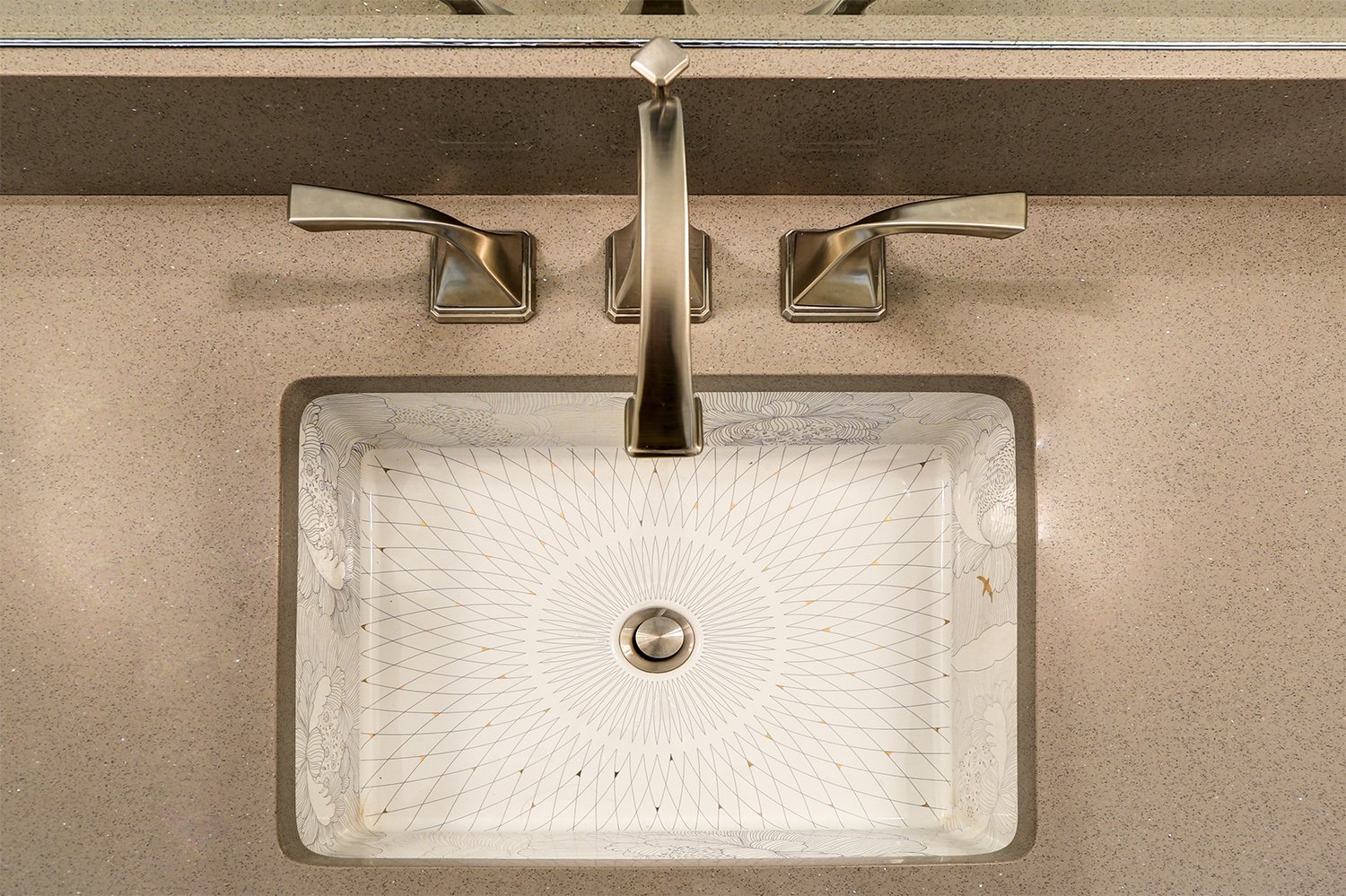
Like a drop-in sink, an undermount sink is separate from the rest of the vanity. However, these types of sinks are installed below the countertop’s surface, so no extra lip will be visible.
This type of sink is a good option if you’re looking to maximize counter space, have a countertop you really want to show off, or are a fan of clean lines. But, while they maximize your counter space, they cut into the space under your cabinet. If you rely on your bathroom vanity for storage, you may want to use a space-saving solution instead.
| Pros | Cons |
|---|---|
| Maximizes counter space | Takes up space in the cabinet below |
| Sleek look with clean lines | Requires a counter that can hold the weight |
| Easy to clean | Skilled installation is needed since it’s heavy |
Best for: Smaller or modern bathrooms

These sinks consist of one or two pieces of porcelain, including a bottom stem that stands on the bathroom floor. This piece hides the plumbing within the hollow chamber of the stem. You’ll also have a basin that sits on top of the stem.
Installing a pedestal sink is an excellent option for those looking to minimize the footprint of their bathroom sink. Of course, with a smaller footprint comes fewer options for storage since there is no bathroom vanity or large counter space to place your items on or under.
| Pros | Cons |
|---|---|
| Doesn’t require a vanity | No storage available |
| Takes up little space | Less design options |
| Easy to clean | Requires a strong wall for installation |
Best for: Vintage-inspired bathrooms

Vessel sinks are statement pieces made of various materials, such as granite, metal, and clear glass, and they sit on top of your vanity’s countertop. They can be a beautiful addition to your bathroom. One thing to remember with these types of sinks is that your faucet must be tall enough to reach the top of the vessel.
| Pros | Cons |
|---|---|
| Visually striking | Don’t include an overflow hole |
| Easy to install | Too high for children to use |
| Frees up countertop space | More difficult to clean |
Best for: Vanities with a sturdy countertop
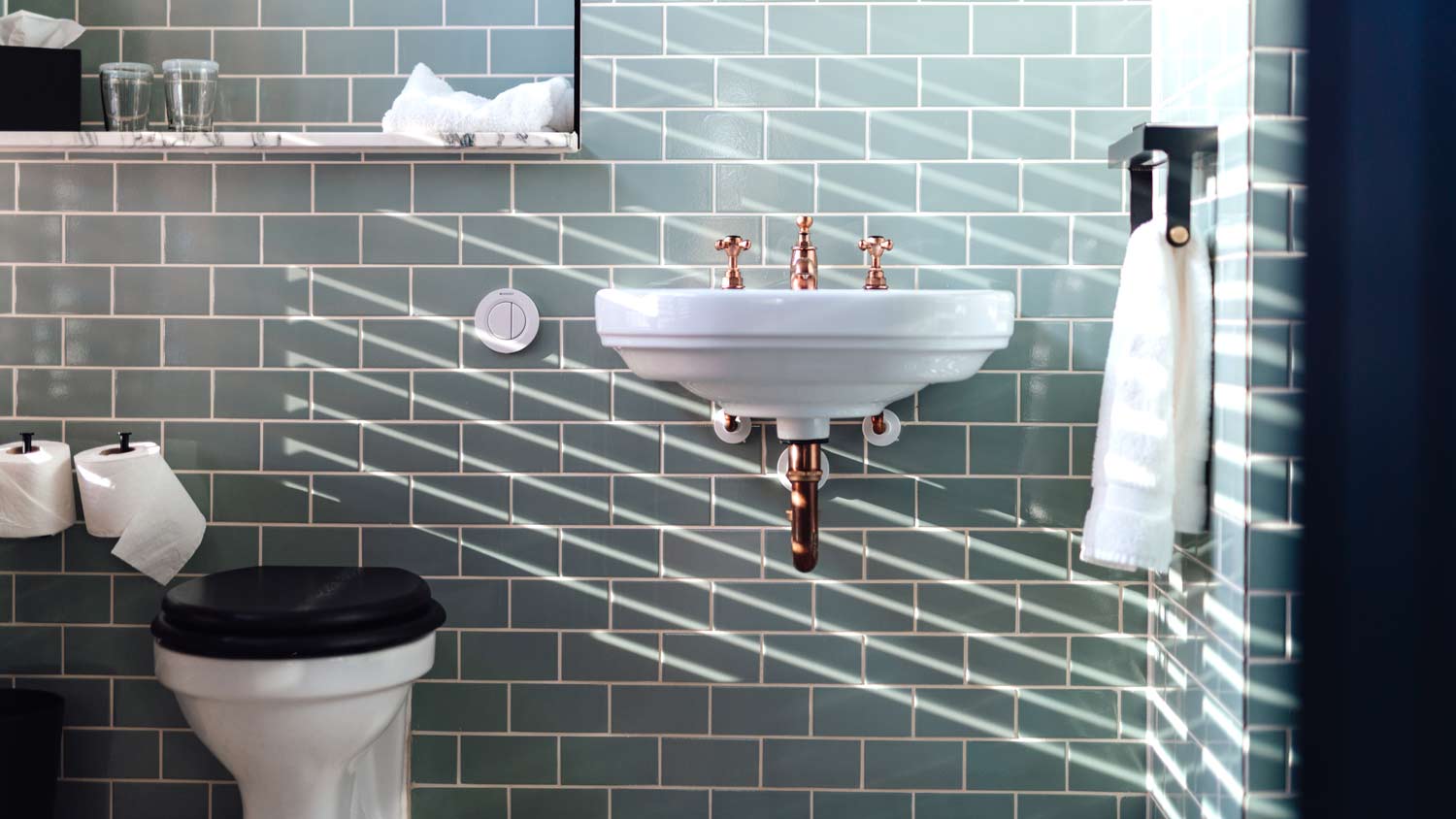
If you’re tight on space or want a more industrial look, you can opt for a wall-mounted sink. These sinks consist of a single bowl mounted directly on your bathroom wall. There is no vanity under them, and the plumbing is exposed. If this is your dream sink, hire a professional sink installer to tackle this challenging installation.
Wall-mounted sinks don’t offer many storage options, so they're best for bathrooms where you won’t need to tuck away as many towels or toiletries.
| Pros | Cons |
|---|---|
| Small footprint | No storage available |
| Flooring is open for use | Exposed plumbing |
| Industrial look | Specialized installation |
Best for: Small or accessible bathrooms with clearance for wheelchairs
The countertop height in a bathroom is 32 to 36 inches tall. For accessibility compliance, the bathroom counter should be 34 inches tall. Keep the regular users of the bathroom and their accessibility needs in mind. Certain sinks, like a vessel design, will increase height, so adjust accordingly.

A corner sink is ideal for small bathrooms or half baths because it can free up valuable floor space. It sits in the corner of the bathroom and is wall-mounted, though it can also be a pedestal sink or part of a corner vanity.
| Pros | Cons |
|---|---|
| Takes up less room | Difficult installation |
| Customizable | Little counter space around the sink |
| Unique look | Hard to clean |
Best for: Maximizing small spaces
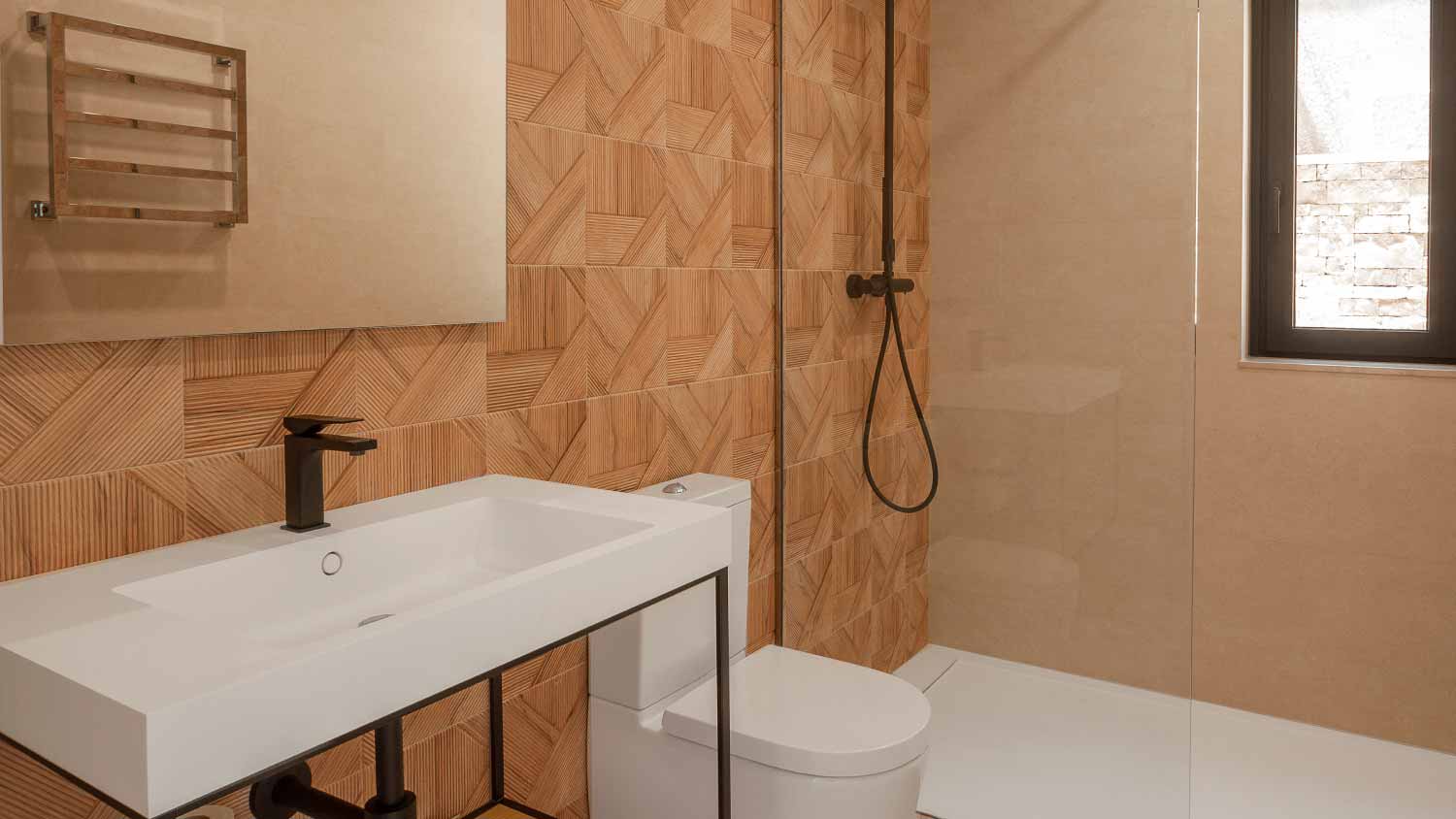
A console sink is a wall-mounted sink surrounded by a countertop with two or four legs. Depending on the size, you may have room for hand soap, a small houseplant, and the like. Console sinks are open underneath, with the plumbing exposed, but some models have shelves where you can store towels and other essentials.
| Pros | Cons |
|---|---|
| Versatile look (from traditional to modern) | Might require add-ons for storage |
| Open design | Limited counter space |
| Easy to clean | Exposed plumbing |
Best for: Industrial spaces or adding charm to small bathrooms
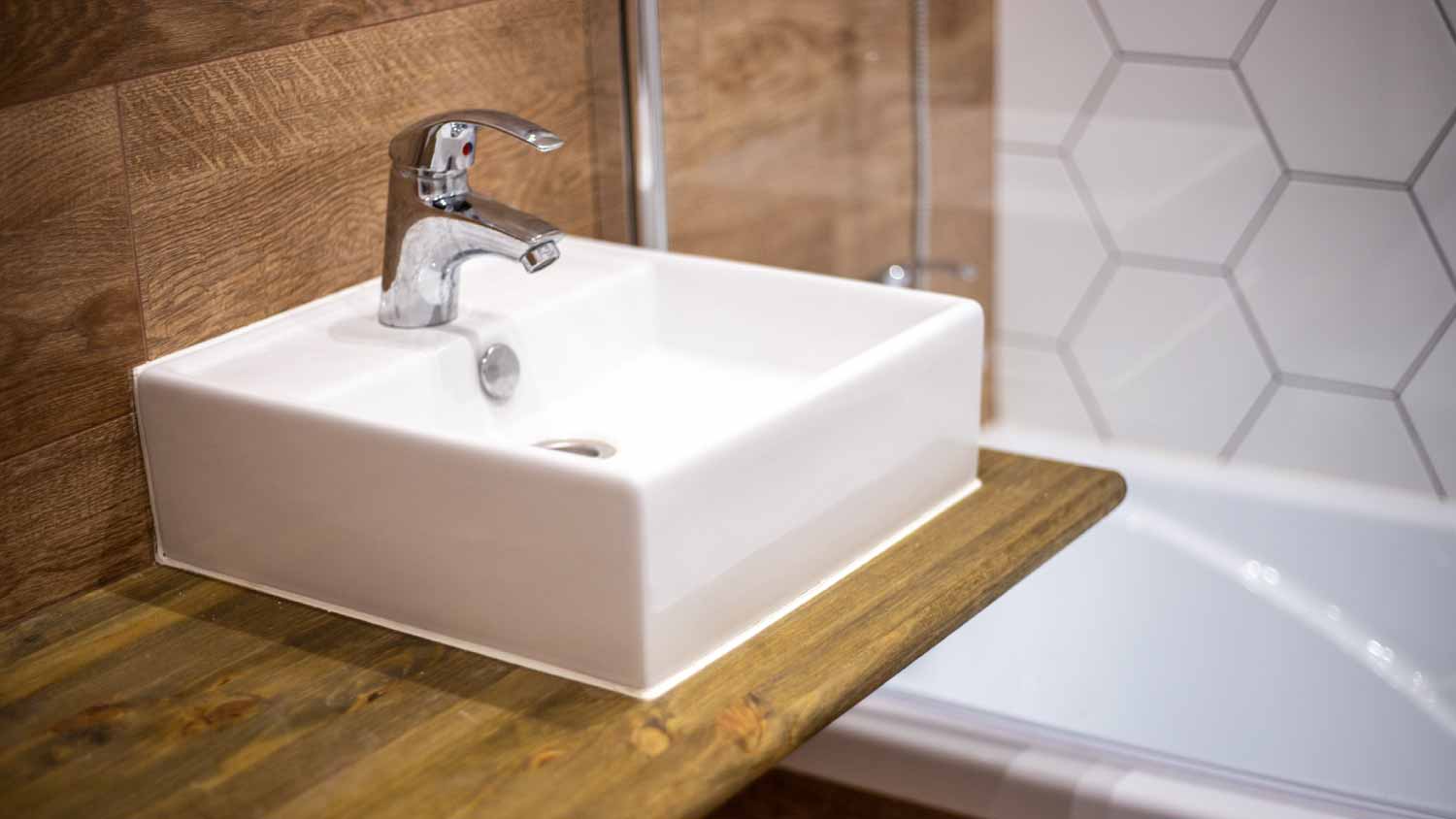
Like a vessel sink, a flat or tabletop sink is attached to the top of a counter or vanity. However, while vessel sinks are bowl-shaped, flat or tabletop sinks are rectangular or oval with a wide, flat bottom that allows for a more durable installation. This style is a little shallower than a vessel sink, making it easier for kids to use, but more water may end up on the bathroom counter.
| Pros | Cons |
|---|---|
| More durable than bowl-shaped vessel sinks | Water can splash on counters |
| Contemporary look | Challenging for kids to use |
| Gunk can build up along the base | Requires a heavy-duty countertop |
Best for: Modern bathrooms
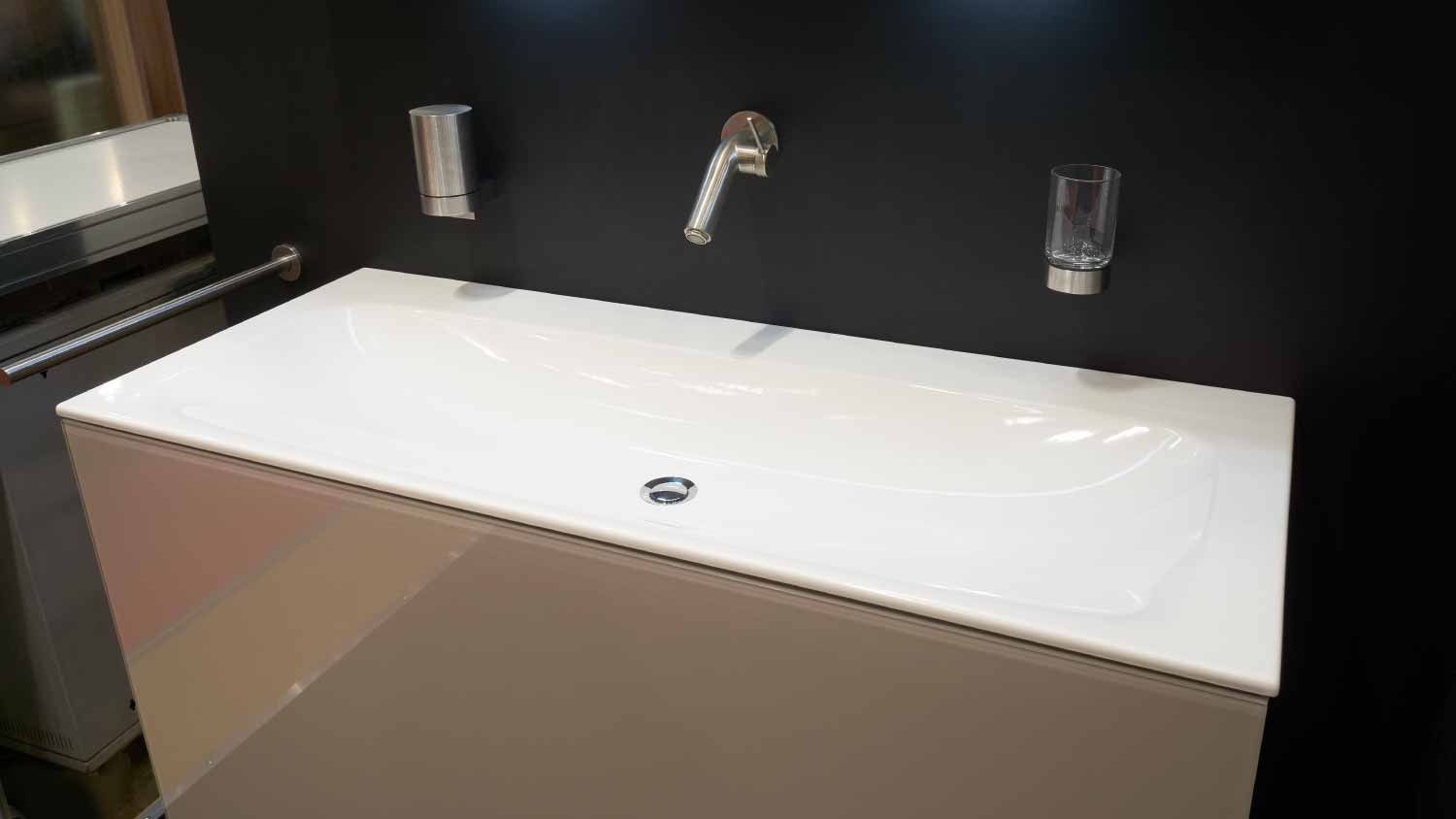
Washplane sinks have a shallow bowl that seamlessly integrates with the counter through a soft slope. These sinks drain into a small trough before the water flows into pipes hidden in the wall. The sleek and minimal design is ideal for modern guest baths or half baths. But because the bowl is shallow, it’s more prone to splashing, so a washplane sink may not be the best option for a busy family bathroom.
| Pros | Cons |
|---|---|
| Eye-catching design | Water can splash on counters |
| Fits into a modern aesthetic | Water takes longer to drain than traditional sinks |
| Range of materials | Shallow and doesn’t hold water |
Best for: Guest bathrooms and low-traffic areas

Often seen in commercial applications, a trough sink takes inspiration from long horse troughs and runs the length of the counter with multiple faucets draining into the same basin. It’s an effective alternative when an average sink size isn’t large enough for your needs. This style is becoming increasingly popular in residential applications as an alternative to having multiple sinks and vanities.
| Pros | Cons |
|---|---|
| Alternative to having multiple sinks | Takes up a lot of space |
| Doesn’t splash as much as washplane sinks | Minimal counter space |
| Customizable | More surface area to clean |
Best for: Contemporary Jack and Jill bathrooms

Natural stone is best for vessel or tabletop sinks where the countertop can support the weight of the stone. If the stone is large enough, it can be carved into a trough sink. Natural stone sinks are incredibly durable, and their patterns and textures add visual interest to a bathroom. They are often made from marble or granite, but they can also be carved from limestone, travertine, sandstone, or river rock.
| Pros | Cons |
|---|---|
| Very durable | Heavy and requires precise installation |
| Adds visual appeal | Requires more maintenance |
| Each sink is unique | Not suited to heavy-traffic bathrooms |
Best for: Luxury guest bathrooms

Metal sinks are frequently made from copper, stainless steel, or enameled cast iron and come in various looks, from rustic to modern. They’re often used in kitchens because they’re durable and easy to clean. They offer an unexpected wow factor in bathrooms. Metal sinks have a long life expectancy and won’t chip, crack, or stain over time.
| Pros | Cons |
|---|---|
| Durable and resistant to stains | Doesn’t fit in every space |
| Easy to clean | Requires care to avoid scratching |
| Long life span | Limited design options |
Best for: High-traffic bathrooms
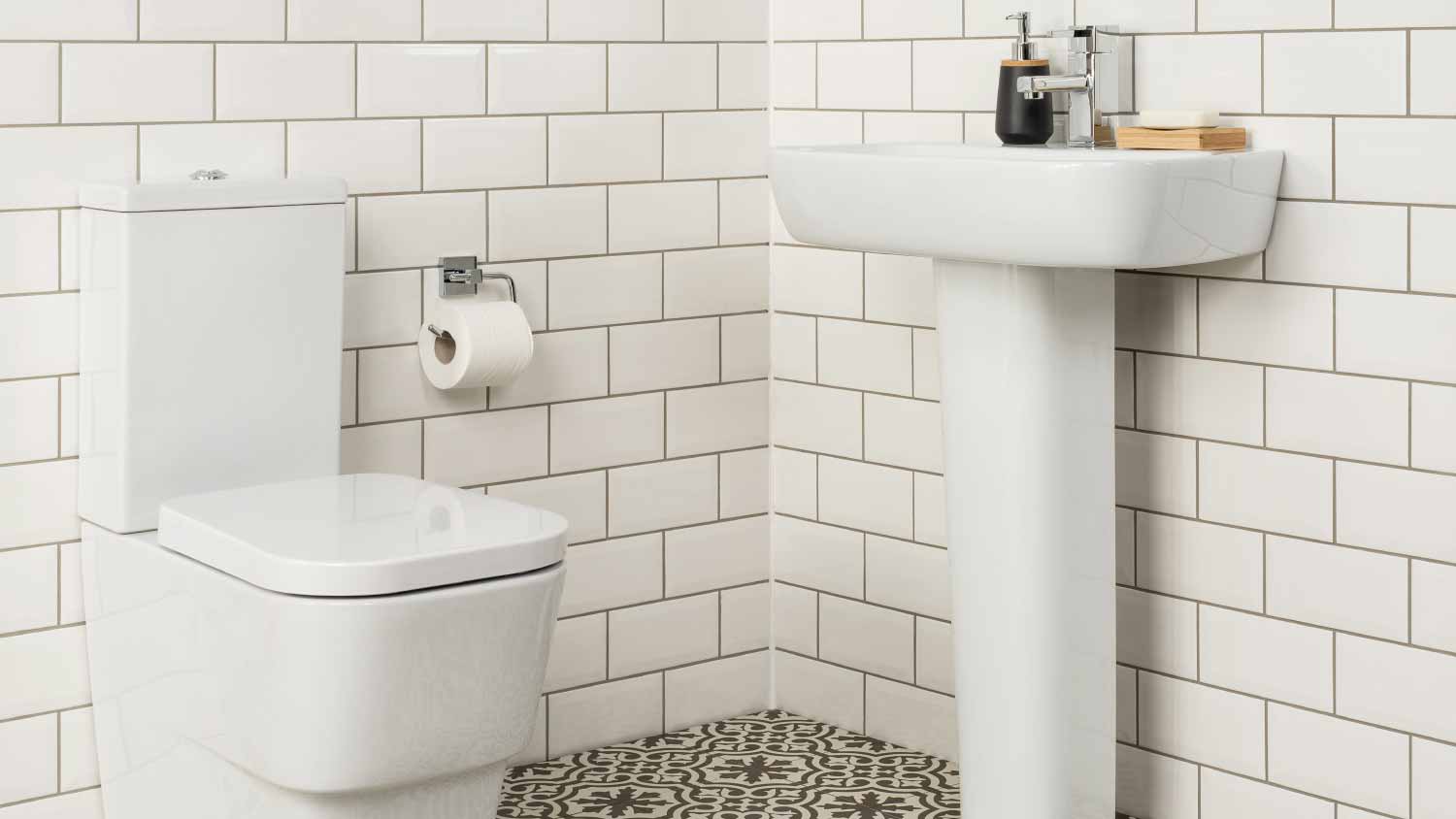
Ceramic sinks are common in bathrooms because they’re widely available and stand up to everyday wear and tear. Not only do they resist scratching, cracking, and staining, but they’re also easy to clean. You’ll mostly see white ceramic sinks in bathrooms, but they come in many colors that can add a surprising touch of style to the room.
| Pros | Cons |
|---|---|
| Budget-friendly | Glaze defects and damage allow staining and discoloring |
| Scratch-, crack-, and stain-resistant | Can crack and chip with heavy impact |
| Easy to clean | Not environmentally-friendly |
Best for: Budget-conscious remodeling projects
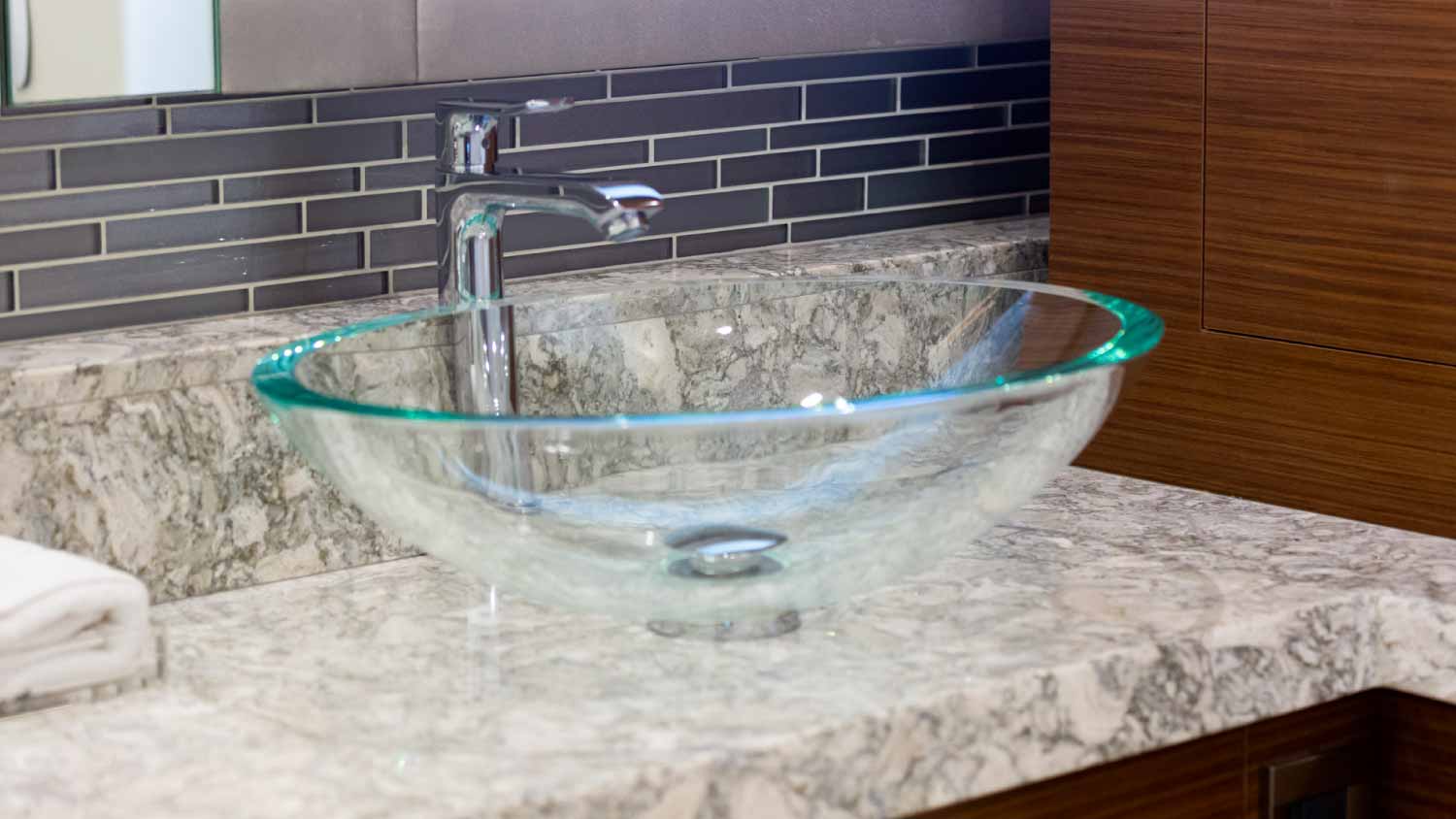
Glass is used for vessel sinks to create the unique bowl on top of the bathroom vanity. Glass is more delicate than other materials and requires frequent cleaning because any grime or buildup will be on full display. A glass sink is a better choice for guest bathrooms or powder rooms that don’t see as much use as the main bathroom or one used by kids.
| Pros | Cons |
|---|---|
| Striking visual appeal | Not durable |
| Easy to clean | Requires frequent cleaning |
| Recycled options available | Higher cost |
Best for: Unique guest bathrooms
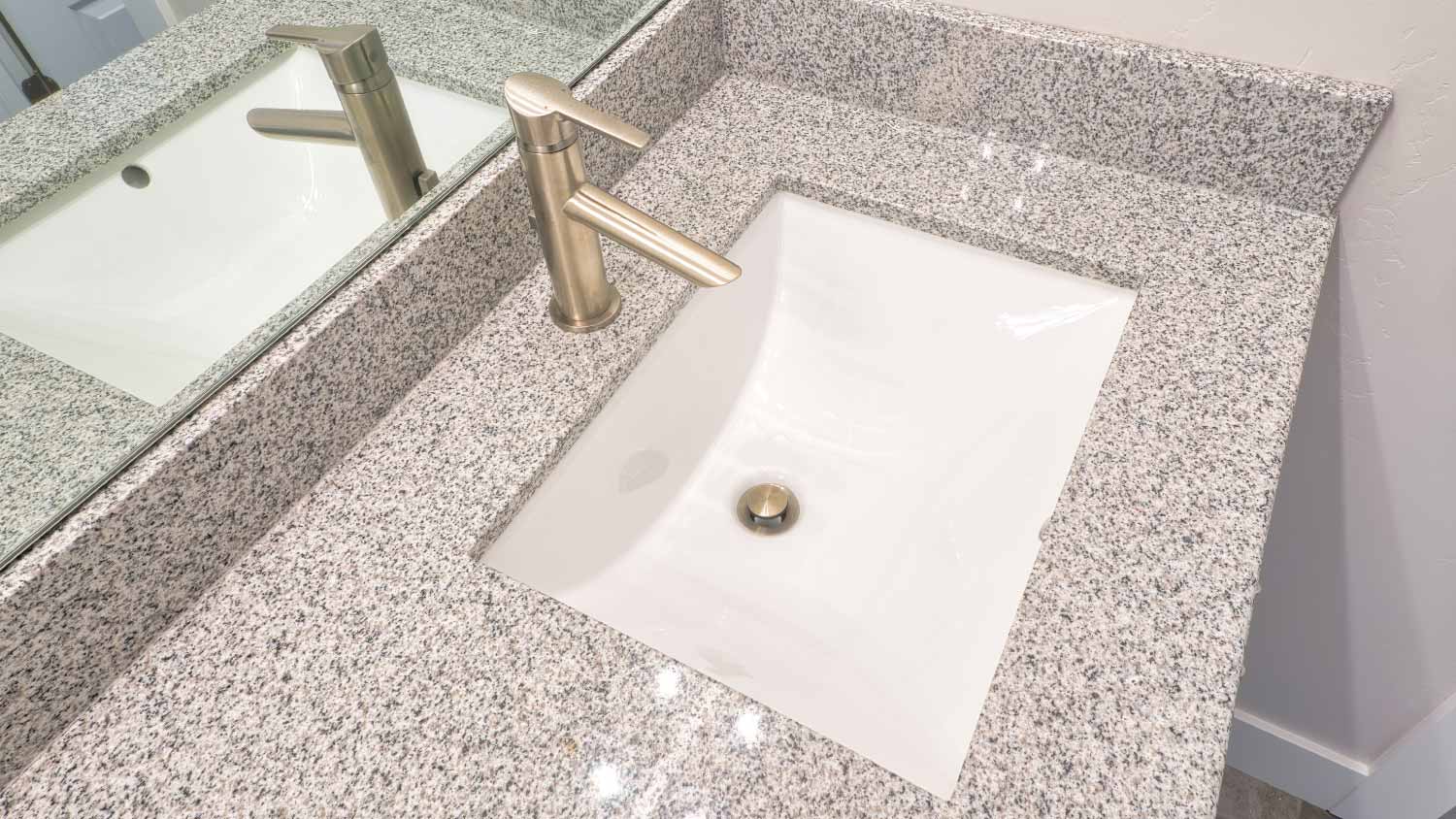
A resin sink, also known as a composite sink, consists of a man-made stone. It’s manufactured with a mix of ground stone or granite and acrylic resin to create an incredibly durable surface. Resin sinks can come in nearly any color, and because they’re cast in molds, they can be nearly any shape. You can sand out scratches on a resin sink and then polish it to restore the original look.
| Pros | Cons |
|---|---|
| Very durable | Higher cost |
| Available in any color or shape | Can’t withstand harsh chemicals |
| Easy to maintain | Heavy |
Best for: Custom bathrooms

Wooden sinks are a stunning and unique addition to a bathroom. They consist of teak or other hardwood that is easy to clean and highly durable. You’ll find options carved from one solid piece of wood, but you’ll also see sinks made up of multiple pieces of wood laminated together.
A major benefit of a wood sink is that any scuffs or scratches in the wood only add to its charm and character. The wood will naturally darken over time, and giving it a coat of oil a few times a year is recommended to protect it.
| Pros | Cons |
|---|---|
| Unique look that can improve with time | Requires maintenance with castor oil |
| Easy to clean | Higher cost |
| Teak is naturally antiseptic | Heavy |
Best for: Rustic-inspired bathrooms

Concrete sinks are the obvious choice if you want a modern industrial look. But now that they’re growing in popularity and are more widely available, you’ll also find options in cheerful colors and sinks that mimic the look of wood. Concrete is highly durable, but because it's so heavy, it’s often used for tabletop or trough sinks. That said, other styles of concrete sinks, such as wall-mounted setups, are possible if installed correctly with the proper support.
| Pros | Cons |
|---|---|
| Wide range of colors and designs | Can crack |
| Sturdy | Requires sealing |
| Easy to clean | Heavy and difficult to install |
Best for: Industrial bathrooms
Since there are so many sink types, it’s easiest to start by figuring out the basics, like your budget, what style you’re looking for, and any specific needs you have. From there, you can narrow down your choices to find your perfect fit.
Any time you tackle a home improvement project, the budget should be at the forefront of your planning. When choosing a new sink for your bathroom, consider the full bathroom remodel cost and how the sink fits into the project budget.
Keep in mind that in addition to purchasing materials, sink installation costs must be accounted for. Contact at least three sink installers near you for a quote.
From fancy Victorian to minimal modern, there are many bathroom sink styles to choose from. Researching bathroom remodel ideas will help inspire you, but ultimately, you should go with something that complements the style of your house and makes you happy. Practical considerations like the square footage of your bathroom will also come into play, which is why it’s helpful to know the difference between, say, a pedestal sink and a console sink.
The material you choose for your bathroom sink will depend on several factors, including your budget and how much use the sink will see. Some materials, like glass, are best for vessel sinks in guest bathrooms. Other materials, like resin and ceramic, are durable enough for high-traffic bathrooms.
The size and layout of your bathroom will help you decide on the sink size. Larger bathrooms can hold a console sink or one with a large vanity, while smaller bathrooms may benefit from a pedestal or corner sink.
Bathroom sinks are most commonly oval, so if that’s the shape you choose, you'll have many options. Other options include rectangular, square, and round sinks. You can also create your own custom shape using a material such as resin or wood for a one-of-a-kind bathroom sink.
Stephanie Mickelson contributed to this piece.
From average costs to expert advice, get all the answers you need to get your job done.

Do you want to add a mudroom to your home but are unsure if it’s within your budget? Use this mudroom addition cost guide to determine your installation price range.

Building an addition can increase your home's value and provide more space to live, but it does come at a cost. Read on to learn how much it costs to build a room addition based on factors like location, type, and size.

Remodeling your bathroom can add significant value to your home. Your bathroom remodel cost in Phoenix, AZ will depend on size, fixtures, materials, labor, and other factors.
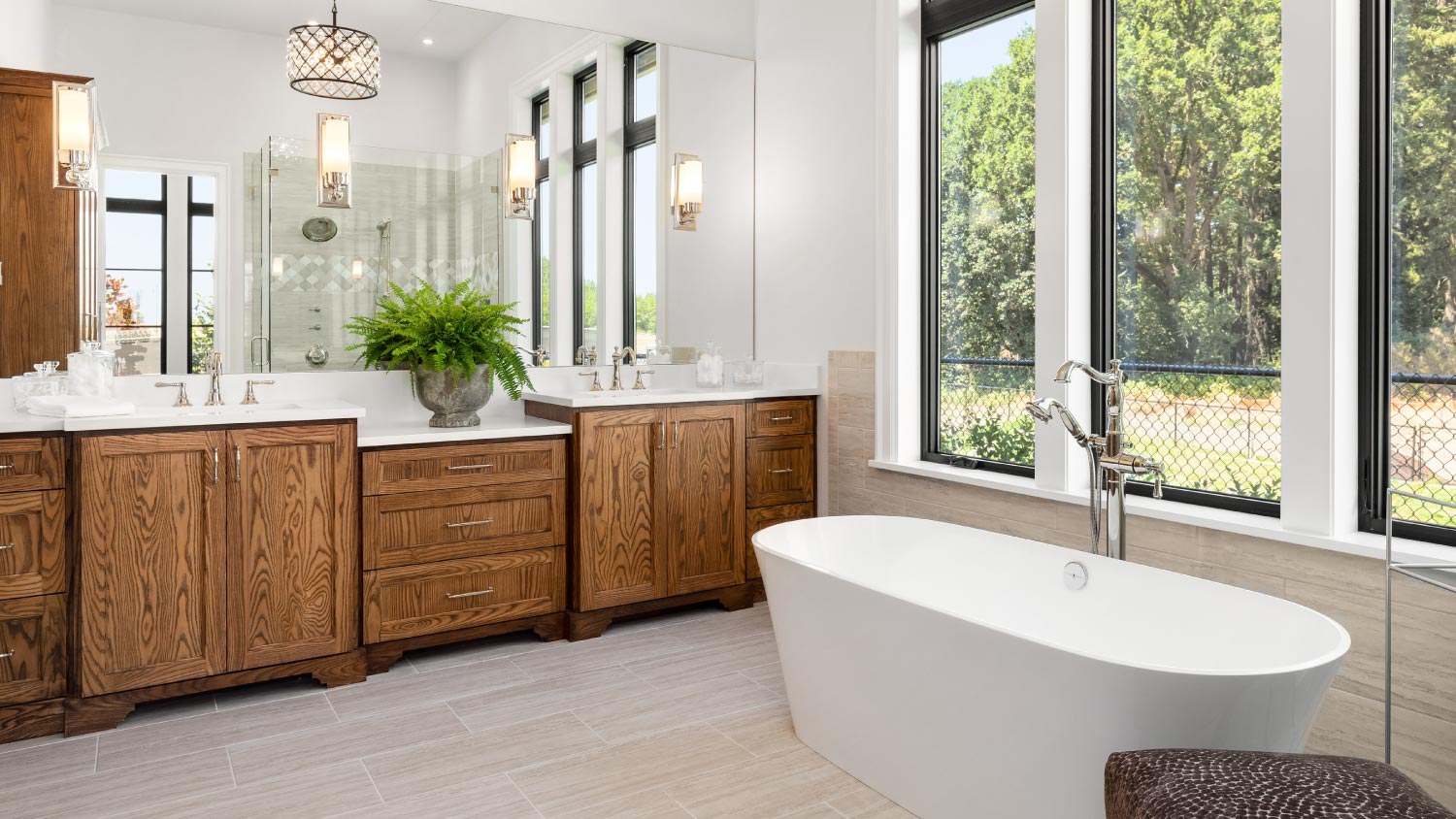
An updated bathtub can give a bathroom a whole new look. Find out how much it costs to replace a bathtub in Tampa, FL, including prices by type and labor costs.

Discover how to dispose of old countertops, including removing, recycling, and donating. Our expert guide has all the info for DIYing or hiring a pro.

Replacing or installing an attic ladder provides a safe way to access your attic. Learn what factors affect attic ladder installation cost to help you budget.